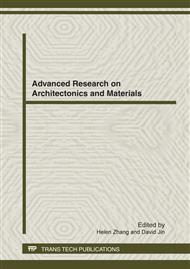p.117
p.122
p.129
p.134
p.138
p.142
p.146
p.150
p.154
The Application Study on Northern Guangxi Residence Materials Elements in Modern Building Design
Abstract:
In order to extract northern guangxi houses design elements, this paper introduces the architectural characteristics of northern guangxi, Through the design characteristics of residential analysis, mainly introduced the traditional local-style dry bar dwelling houses, village gate, the drum design style, From natural factors, cultural factors, technical factors three aspects analyzes the traditional dwelling houses design materials elements, Put forward some suitable for modern residential traditional residence elements of application design practices, explore the traditional elements and modern building design method of integration way , The modern city residential design to meet residents in modern life requirement at the same time, show adequately traditional houses north guangxi region characteristic, continuity and promote the local traditional architectural culture.
Info:
Periodical:
Pages:
138-141
Citation:
Online since:
April 2012
Authors:
Price:
Сopyright:
© 2012 Trans Tech Publications Ltd. All Rights Reserved
Share:
Citation:


